RAF No. 346 (GB/II/23 Guyenne’) French Squadron
Formed at Elvington on 16th May 1944, it was composed of French Personnel who had been in North Africa. It was equipped with Halifax Vs initially, but by the time it became Operational, in June 1944, it was mainly equipped with the Mk.III. The Squadron remained as part of Bomber Command’s Main Force until the end of the War, beginning to re-equip with the Halifax VI in March 1945. The Squadron was transferred to the Armée de l’Air on 27th November 1945. Squadron Code Letters H7
Commandant du groupe:
Lt.Colonel Gaston Vénot 25th October 43 to 10th September 44
Commandant André Puget 10th September 4 to 11th August 44
Commandants en second :
Cne André Puget 25th October 43 to 10th September 44
Cdt Léon Demazure 29th October 44 to 19th May 1945
Commandants de la 3 eme escadrille :
Cne Simon 25th October 43 to 24th October 44
Cne Jean Thiry 24th October to 11th March 1945
Cne Antoine Goepfert 11th March 45 to 1st September 45
Commandants de la 4 eme escadrille :
Cne Raoul Marias 25th October 43 to 8th November 44
Cne Raymond Brohon 8th November 44 to 6th February 45
Cne Eugène Martin 6th February 45 to 21st May 1945
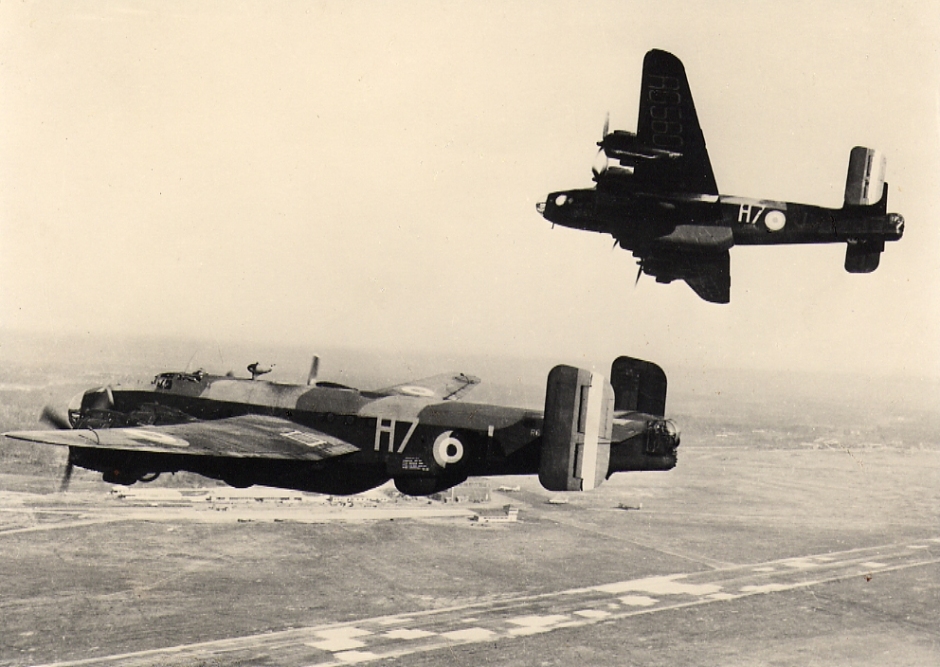
The Squadron letters appear to have been blacked out in this image over Elvington. The French contingent went on to Fly 2,700 Sorties deep into Nazi Territory and both Squadrons lost 15 Aircraft each. RAF Elvington became quite literally a French Enclave, a Foreign Territory on Yorkshire Soil and the only one of its kind in the United Kingdom.

346 Guyenne Squadron was Officially formed under the Command of Colonel G E Venot.
The Base itself was under the Control of Commandant Puget, who was responsible to Air Commodore “Gus” Walker & Air Vice Marshall Carr, who had overall Command of 4 Group. The Squadron Mascot was another idiosyncrasy. A Piebald Rabbit which became the living embodiment of the Guyenne Squadron Insignia and a much-loved source of comfort to many.
No.346 Guyenne Squadron (Code Letters H7-) was formed at RAF Elvington, near York, on 16th May 1944, and was the 1st of the 2 French Air Force Heavy-Bomber Squadrons which served in this Country in the WW2. The Squadron’s CO & Aircrew were French but the Adjutant was English. Beginning Operations with Halifax V’s on 1st June 1944. So, with a strong sense of Camaraderie & Purpose, the French were ready and settled in preparation for the Battles ahead. Just 2-weeks after being formed, 346 Squadron was called into Action on the Night of 1/2nd June 1944, in an Operation directly in support of the imminent Normandy Invasion of D-Day. 12-Aircraft from the Squadron helped make up the combined Attack Force of 110 Bombers. The Target was the strategically important Radio Station at Ferme d’Urville, near Cherbourg, which was completely destroyed. All 346 Squadron Aircraft returned safely, one having returned early due to the failure of the Gee Navigational Aid. That Aircraft Commander, Capitaine Baron, had refused to Bomb France if he could not be sure of being Accurate. The Mission had been supervised at Elvington by Air Commodore Augustus Walker. After having studied the results of the Mission, Gus Walker announced that he was completely satisfied with the competence of the French Crews and that he would not take a Supervisory Role again. True to his word, he did not and a Bond of Mutual Trust & Affection was built. This Raid, taken in conjunction with another by 617 Squadron, led by Group Captain Leonard Cheshire on the Radar Stations at Douvre & Le Havre on 5th June, was vital to the success of the Normandy Invasion. The Enemy had been left virtually Blind in the area of the English Channel and was unable to mount a Naval Challenge that could have thwarted the Invasion.
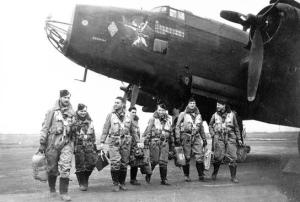
Capitaine Marchal – French Crew of Halifax III ‘La Marseillaise‘ of No.346 Squadron (GB II/23 “Guyenne“) walking from their Bomber at Elvington in 1944. Elvington had been selected as the Base for 2 new Heavy Bomber Squadrons manned by Free French Personnel Flying Halifaxes in No.4-Group. These were 346 (Groupe 2/23 Guyenne) & 347 (1/25 Tunisie). formed at Elvington in May & June 1944 respectively, both becoming Operational in the latter month. The Squadron’s Commanding Officer & Aircrew were French but the Adjutant was English. Many of the original Aircrews had previously Served with the French Air Force in North Africa. Both Squadrons played a major part in the Bomber Offensive. Elvington was the only Airfield in the United Kingdom used by the remainder of the Free French Forces, they also Flew Handley Page Halifax Heavy Bombers until they moved to Bordeaux in October 1945 where they became the basis for the new Air Force of Liberated France.
On 13th October 1944, Sir Arthur Harris received the Directive for Operation Hurricane: ‘In order to demonstrate to the Enemy in Germany generally the overwhelming superiority of the Allied Air Forces in this Theatre – the intention is to apply within the shortest practical Period the Maximum effort of the RAF Bomber Command and the 8th USAAF against objectives in the densely populated Ruhr.’
Another Bomber Attack on Bochum took place on 4th November 1944
749 Aircraft
384 Halifaxes, 336 Lancasters, 29 Mosquitos – of No.s 1, 4, 6 & 8-Groups. This was a particularly successful Attack based upon standard Pathfinder Marking Techniques. Severe damage was caused to the centre of Bochum. More than 4,000 Buildings were destroyed or seriously damaged. Bochum’s Industrial areas were also severely damaged, particularly the important Steelworks. This was the last Major Raid by Bomber Command on this Target.
23 Halifaxes & 5 Lancasters were lost; German Night Fighters caused most of the Casualties. No.346 (Free French) Squadron, based at Elvington, lost 5 out of its 16 Halifaxes on the Raid.
The last Free French Operations from Elvington took place late in April 1945, but both Squadrons did not leave for their new Home Bases in Bordeaux until October. During their Operations, the French had lost 30 Halifaxes as Missing in Action.


Capitaine Marchal, Based in Elvington, and he was a rough, tough French Pilot with a dashing moustache. The creature he holds is the unimaginatively named Lapin, equally as rough, tough & War-weathered. Lapin was the living embodiment of the Guyenne Squadron’s ‘white rabbit’ Insignia – a Mascot for the men, but not a Piebald Pet of the Pampered kind. Lapin would often become a flying rabbit – taken on Bomb-running Missions in a Basket over France (subject to Altitude & Oxygen) by Capt Marchal. Together they endured the shudders of Flak and the Staccato pinging of Bullets from German Night Fighters – Warriors both. Lapin proved to be the Captaine’s lucky charm. He survived 30 Missions in Halifax Bombers. He even Survived the horrific Explosion at Elvington when one Bomb fell during the Loading procedure in 1944, destroying his Halifax and taking the lives of 5 Ground Crew Personnel. Lapin was unscathed. (Inset) Capitaine Marchal of 346 “Guyenne” Squadron is debriefed by Fl Off Ginette Plunkett of the Duxieme Bureau (Military Intelligence) at Elvington following a Bombing Raid on the German Ruhr Valley in 1944
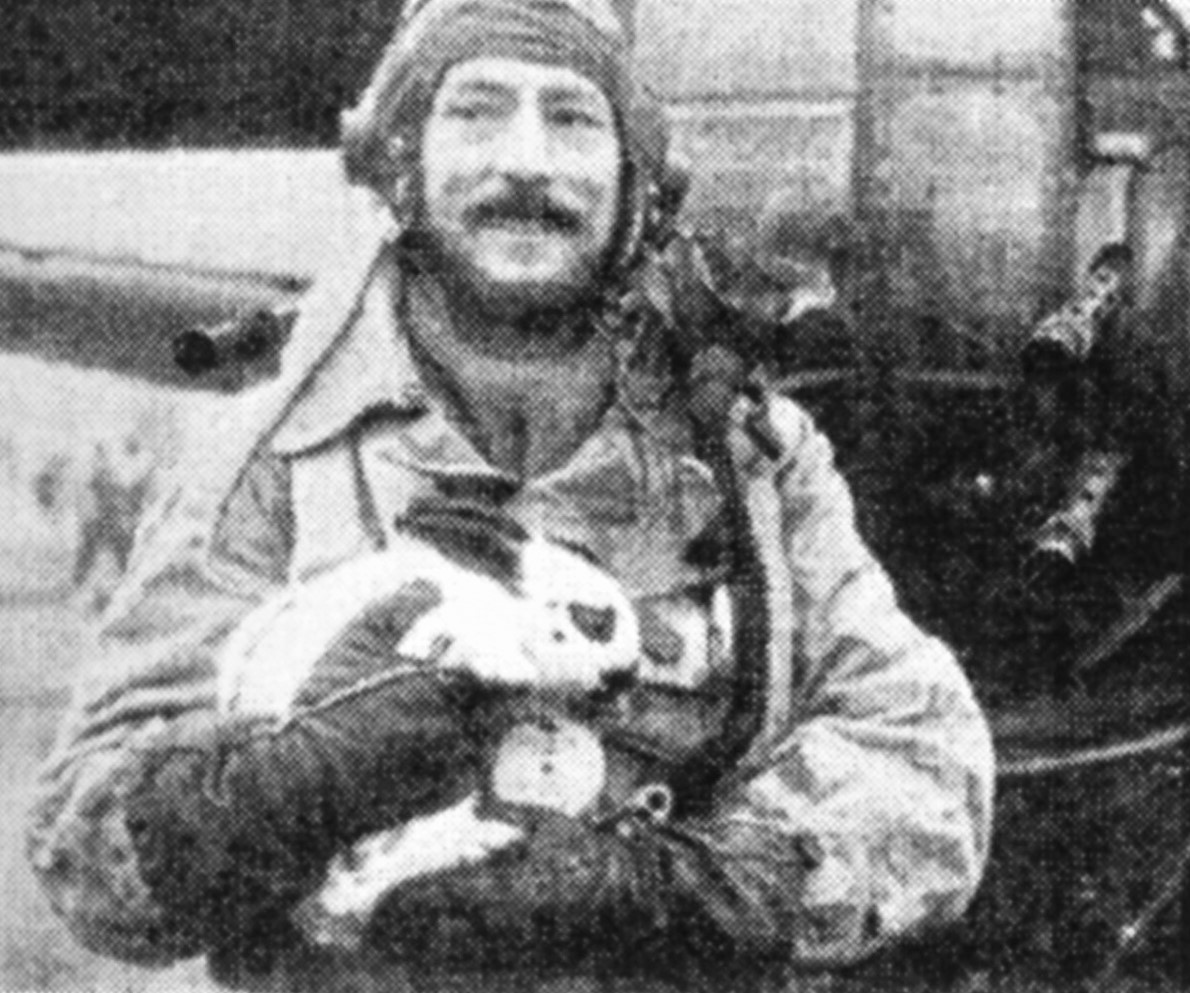
Beginning Operations with Halifax Vs on 1st June 1944, No. 346 switched to Halifax IIIs the following month and continued solely with these until March 1945, when it began to use Halifax VIs also. Over a span of 11 months it Flew 1,479 Operational Sorties (1,371-Bombing & 108-Emergency Transport), dropped 4,644 Tons of Bombs, and during the period 25th September to 2nd October 1944-ferried 80,875-gals of Petrol from Elvington to Brussels for the 2nd Army.
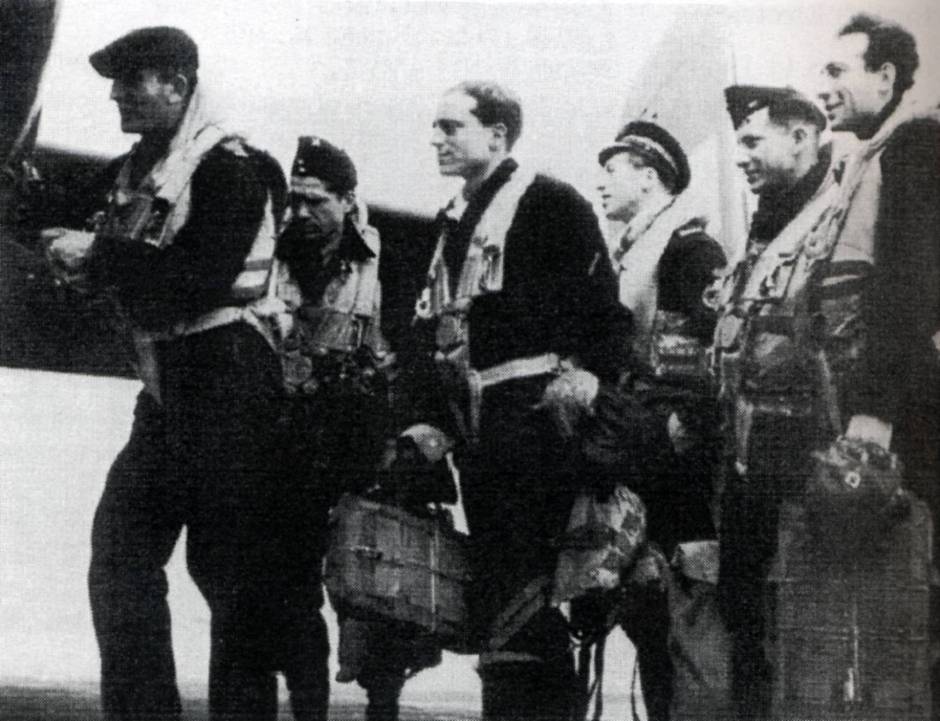
JB781 KN-W Mk ll Series 1 Piloted by Flt/Lt David J Clark from July to November 1943 (13 Ops). This Halifax Aircraft was transferred to No.346 ‘Guyenne‘ Squadron manned by French Personnel also Based at RAF Elvington.

Halifax Aircraft from RAF Elvington’s newly formed French 346 “Guyenne” Squadron took part in the Offensive against Strategic Targets on the Normandy Coast in the run-up to D-Day. On these Operations, they Attacked firstly the Radio/Radar Installation at Ferme D’Urville, in the early hrs of 2nd June 1944, in which 12-Guyenne Squadron Halifax Bombers participated, from the total of 101-Aircraft. The next Night saw Capt Gris-Nez (Harinzelles) attacked, with 9-Guyenne Aircraft taking part in a total deployment of 271-Aircraft. Lastly, on the eve of D-Day itself, the Target was the historically little known but huge German Heavy Gun Battery at Grandcamp Maisy, Omaha Beach, with 12-Guyenne Aircraft taking part from a Total Force of 1012 Aircraft, showing the intensity & importance of this Attack.
13th July 1944 Halifax NA551 Capitaine J Gaubert FFAF (Navigator) Lieutenant R Pasquier FFAF (Pilot) – (According to French Air Force Custom, the Aircraft Captain was the Senior-ranking Crew
Member, not necessarily the Pilot).
This Aircraft of 346 Squadron Based at RAF Elvington was returning from the Target at Hautes-Buissons, France, and was in the Circuit at Elvington awaiting its turn to Land when it Collided with Halifax NA546, also in the Landing Circuit. Control of NA551 was immediately Lost and it Crashed near Dunnington, York, Killing the Crew. (See next Listing.)
13th July 1944 Halifax NA546 Capitaine Jules Roy FFAF (Bomb-Aimer) – Lieutenant J Gronier FFAF (Pilot)
Halifax NA546 – also from 356 Squadron based at RAF Elvington and returning from the Target at Hautes-Buissons, France – had probably Hit NA551 (above) with a Wing and damaged a Propeller, causing severe vibrations. The Aircraft Captain ordered the Crew to Bail out and he and the Rear Gunner successfully did so. However, the Pilot was able to reduce the vibrations by Feathering the damaged Engine Prop, countermanded the Order to Bail Out and was able to Land safely. No Injuries.

Free French Halifax H7-C Flies over Liberated Paris
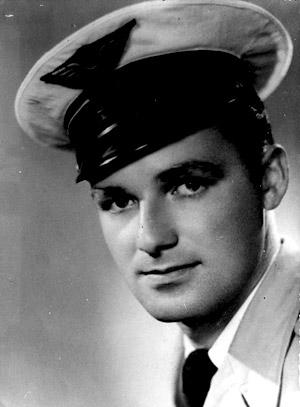
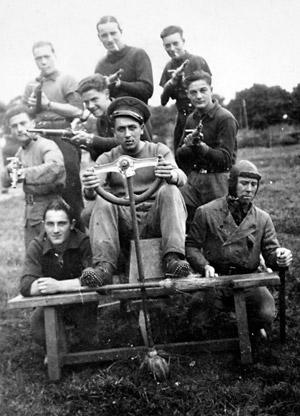
Henri Martin
Mid-Upper Gunner
Emile Haim Mechaly France’s most decorated Mid-Upper Gunner at the wheel of a makeshift chariot of War and his aggressive French Aircrew in support.

Mid-Air Collision with the Tail of another Aircraft slices off the Nose Canopy with the Loss of the Bomb Aimer & Navigator but despite the severe damage, it was able to return to Base.

In addition to the Memorial in the Village of Elvington, there is also a Memorial in Normandy at Grandcamp-Maissy (also home to the Rangers Museum). The reason for the Memorial was that the Night before D-Day these 2 French Squadrons actually Bombed Normandy – the 1st & only time they Bombed their Home Country. The Target for the French Bomb Group was the Maisy Battery – just outside Grandcamp-Maisy. The Batteries (3 of them) were positioned to Fire on both Utah & Omaha Beaches and did so successfully until they were silenced by the US Army Rangers on the 9th of June 1944. Unfortunately, the Bomber Mission did not succeed in silencing the Guns.
On the Night of D-Day -1, Sir Arthur Harris had ordered the Deployment of every available Aircraft within Bomber Command and on that fateful Night, 1,136 Aircraft dropped the largest weight of Bombs since 1939 on the Coastal Batteries along the Atlantic Wall. Twelve Aircraft from 346 GuyenneSquadron were among a Force of 150 whose specific Target was the Heavy Battery on the Cotentin Penninsula at Grandchamps Maisy. This was in a vital position in relation to Operation Neptune, the Initial Assault Phase of the Overlord Campaign. The destruction of the Gun emplacements was another crucial factor in the success of the Landings. On return to their Bases, these Aircraft Overflew the massed Armada of more than 4,000 Vessels steaming towards Normandy, which were clearly visible in the early morning Sun. Only a few short hours after de-Briefing had finished, the Crews were assembled again for the instructions for the next Operation. The Target for the French Crews on the Night of June 6th was the Railway Station of St Lo and the German Headquarters position. Similar Rail & Road Junctions at Coutances & Caen were also attacked that Night. Civilian Losses were Inevitable & Heavy.

Around Maisy 12No. 88mm Flak Guns were placed to Counter the Allied Airforce. By coincidence 1000 men from Flak Regiment No.1 were relocated to Maisy with their 88mm & 20mm Guns on 5th June 1944, to Defend this Region. Near La Cambe some 1500-men were Stationed there for the Defence of that Region. Flak-Regiment No.1 was under the Command of Colonel Werner Von Kistowski. Before the Allies Llanded on June 6th, 1944, they tried to Bomb the Complex. But unfortunately most of the Bombs were dropped on Grandcamp-Maisy and 10-Citizens were killed. Because the Turning Point for the Allied Bombers was above the Maisy Battery, they came within Range of these Flak Guns, and some 12 Bombers were shot down. But the Flak Regiment suffered some Losses, and they were pulled back to La Cambe. Within a few hours, the Germans lost 100-men. The Complex at Maisy itself was unharmed.
Someone Ordered the US Engineers to bury the Maisy Site after the Battle. Colonel Rudder did not tell anyone that he knew anything about Maisy… even though we have a copy of his Orders and his Intelligence pack which is full of Maisy Briefings and Aerial photos of Maisy etc. Even after the War, Colonel Rudder never mentioned Maisy – even though he knew that his men had fought & been wounded there. In the case of Major Sullivan for example – Major Sullivan won the Distinguished Service Cross for 3-No. D-day Actions…
1 His Actions on D-Day to get his men off the Beach.
2 The Relief of Pointe du Hoc.
3 The taking of the Batteries at Maisy.
Gary Sterne, discovered the huge “Maisy Battery” after he found a crinkled Map which fell out of an old pair of US Serviceman’s Trousers at a Military Memorabilia Fair in Stockport. The father-of-2 from Cheadle Hulme, Cheshire, has bought a house close to the Battery and subsequently spent £1,000s buying the 40-acres covering the Site from 32 different Landowners. He then spent 2-yrs excavating the Site. The Germans built Maisy in total Secrecy whilst letting the world know all about the nearby Battery at Pointe du Hoc. The net effect of that was to divert all the Allied attention towards the Site at Pointe du Hoc – which of course was not Operational and under Construction on D-day. Maisy was hidden for over 63-yrs – and now you can visit Bunkers, touch German Field Guns and walk inside miles of Trenches & Emplacements.

Bombing of Caen
Almost 11 months after commencing Operations, the French Squadrons Flew their last Mission, on 25th April 1945. The daylight Raid was to finally silence the once-formidable Gun Batteries at Wangerooge, which protected the Entrance to the Harbours of Bremen & Wilhelmshaven.
Ian Reed, Director of the Allied Air Forces Memorial, comments:
“As the French were effectively Bombing their own Homeland, it can only be speculated the torment that those Aircrews underwent on those 1st Operations, but they were fiercely determined to Liberate France from Nazi Occupation. It is fitting that No.346 Guyenne Squadron Aircraft was involved in those early steps towards the Liberation of Europe, and indeed Air Vice Marshal Carr, who was Commander of 4-Group Bomber Command, terminated the 1st Crew Briefing with the words: “…. this is a great day for you”. Mercifully, Guyenne Squadron escaped casualties on these 1st Missions, although the Tally mounted steadily as their Operations increased and the Squadron was joined by No.347 Tunisie Squadron, (Scrutiny of Bomber Command Losses in the period 1st June to the Night of D-Day itself suggest that 45 Bomber Aircraft were lost in Operations on the Normandy Coast, with 228 Aircrew killed, 30 PoW’s, 30 Evaders & 10 injured.)
French Armourers enjoy the Yorkshire sun outside a Nissen Hut

Unpacking the Kitbag – Pipesmoker Lt De Preval

Pilote: S/Lt. Pierre-Albert BAYLE.
Lieutenant of 2/23 Bomb Group “Guyenne” Pilot Officer of a very good Bombing Crew engaged with Bomber Command in the Fight against Germany. They took part in attacks on distant Targets and the powerfully defended Germany. Including on 14th February 1945 the important Goal of Saxony in direct aid to the Soviet Troops Operating in this Sector. Displaying the qualities of enthusiasm, self-control & composure.21st February 1945, participating in a major Raid on a Target heavily defended by intense Flak and a very aggressive Enemy Defence – Halifax disappeared with its Crew.

Colonel: BAILLY – 2e PLT – Pilote (also Flew with KN-W OOR Wullie)
Along with British & Allied Crews within RAF Bomber Command, over 50% of their young Aircrews were killed, often in horrific circumstances, for the Liberation of France & Europe. The young French Airmen were renown for the skill & accuracy of their Flying, aware that in many cases, they were Bombing their own Country, yet the loss rate for Flying these extremely dangerous Missions was very high. Their courage, humour & style were typically French and they became very popular in their unique dark blue uniforms with gold braid. Many married local Girls and the area around the Base soon became known as “Petit France”. On 20th October 1945, the 2 Squadrons returned to Bordeaux to become the Air Force of the newly Liberated France and transferred from RAF to French Control on 15th November 1945
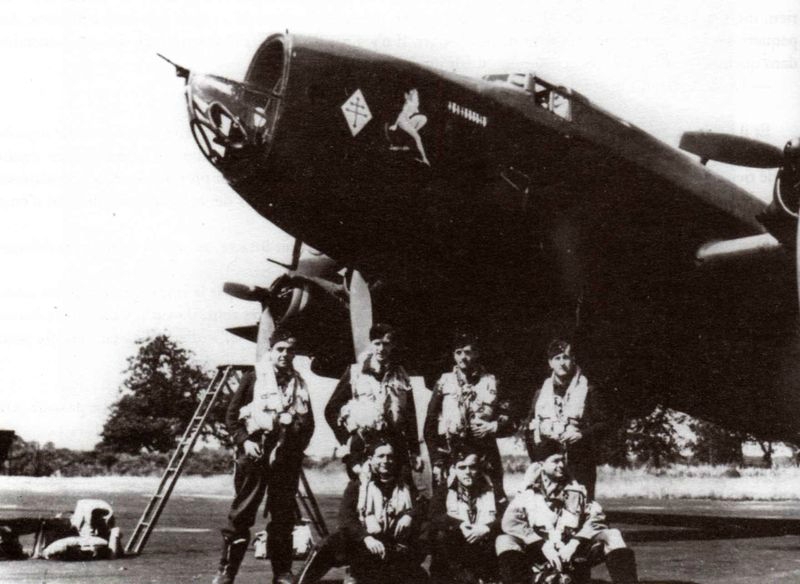
Halifax NR181 H7-J & Aircrew: L-R: Commander Pilot Robert Baron (KIA); Lt. Armand Truche (Evader); Adj. Guy Vigneron (KIA); Adjudant Rene Mignot (PoW); Sgt C Charles Cormier (KIA); Sgt C Roger Petitjean (PoW); Sgt Louis Bourelly (KIA). Passenger – Lt. Col. N Dagan not shown.
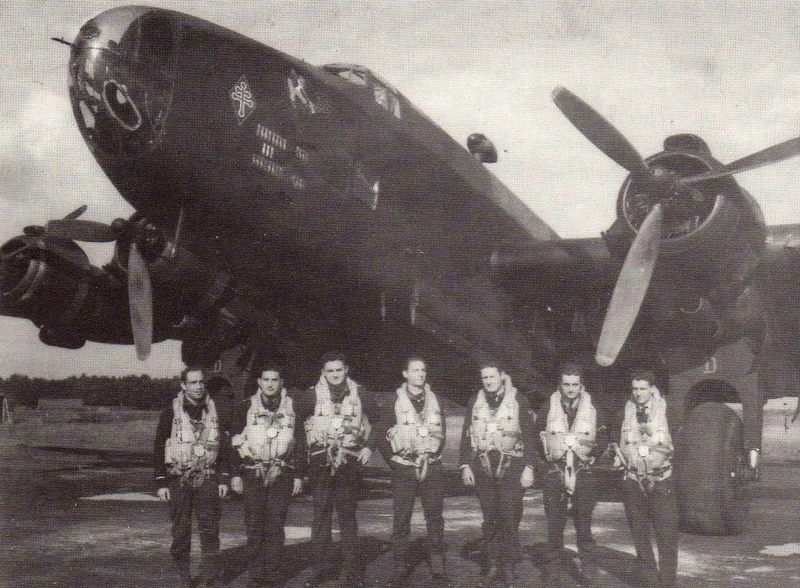
Halifax NA 121 H7-D and Aircrew: L-R Pilot Adjutant R Guise (KIA); Commander Lt Maurice Dabadie (KIA); Sous Lt Alfred Pothuau (KIA); Sgt A Alavoine (PoW); Sgt Henri Lelong (KIA); Sgt Jacques Vautard (PoW); Sgt Marcel Vega (KIA)
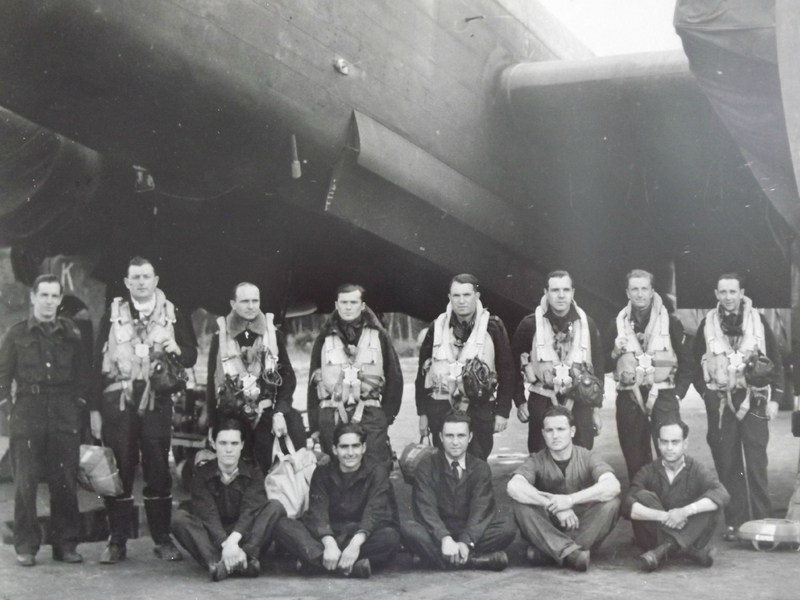
Halifax NA549 H7-M and crew (L-R in Flying Suits): Pilot Capt Alphonse Beraud (KIA); Lt Pierre Valletta (PoW); Lt Pierre Raffin (KIA); Adjutant Jean Cloarec (PoW); Sgt P Imart (PoW); Sgt C J Bellon (PoW) Adjudant Jacques Manfroy (PoW). This image also shows Ground Crew 1 to left & 5 in front of the Aircrew.
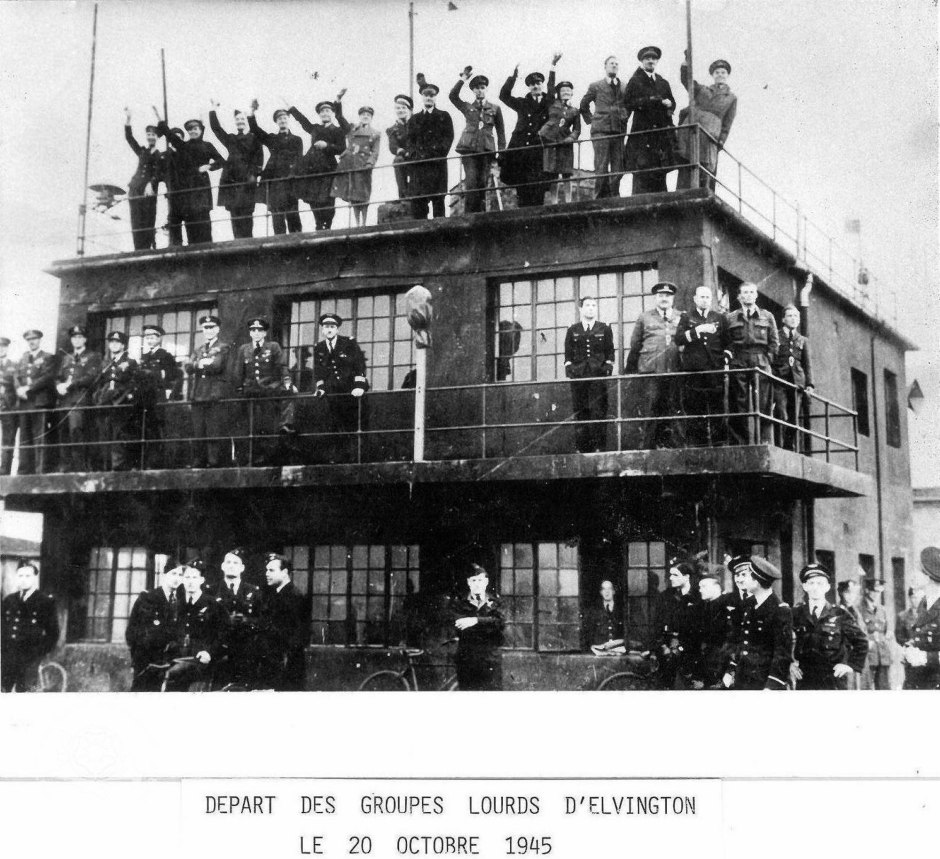
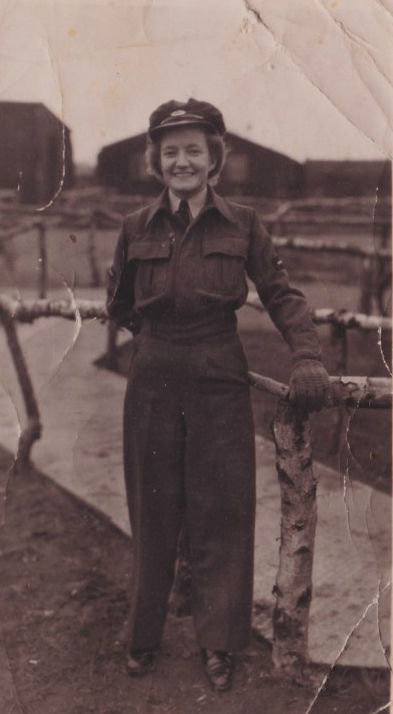
LACW Joan Hayes who stayed behind at Elvington to work on behalf of the Free French Squadrons is also on the Top of the Control Tower waving Farewell, 4th from the Right – she was quite a small Woman.
She also had a another Photo from that Period with her looking up into the Bomb Bay of one of the departing Free French Halifaxes. They had filled it entirely with Bicycles to take back to their New Home Base in France.
Joan was Stationed at RAF Elvington for about 2-yrs, mostly while the Free French were there, and she told me she was the only English Woman permanently on the Site during that time. (A few others came in Daily to Work in the NAAFI etc).
She was one of a small Group of Staff under the Station Commander, effectively his Secretary – she was an excellent Shorthand Typist, having been Trained by Rowntrees in York. Earlier in the War, she had been Engaged to a Bomber Pilot in 75-Squadron who was Lost over Germany in 1941. In 1945 she was Mentioned in Despatches for her part in discovering a Gold-Smuggling Organisation Operating between England & France.

